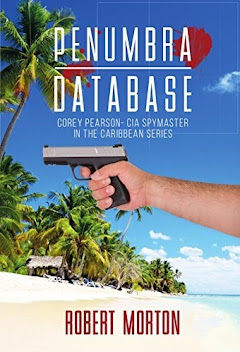 |
| By day, he’s a globe-trotting photographer. By night, a covert CIA operative. The truth is hidden in plain sight |
He’s the guy next door with a quiet smile and
a camera bag slung over his shoulder. Says he shoots wildlife photos for
international magazines. She’s the charming woman upstairs who books luxury
safaris and always seems to be jetlagged but glowing. The tech guy who never
leaves his laptop. The sweet couple who do destination weddings. That quiet
analyst who never comes to the building happy hours.
They might all be telling the truth—or
they might be CIA.
Some CIA operatives don’t just vanish into
foreign countries under fake passports and aliases. When they come
home—especially those working under non-official cover (NOC)—they carry those
fabricated identities right back into everyday American life. The mission may
be over, but the deception stays.
I
remember sitting across from Tony Mendez at an AFIO luncheon years ago. Calm,
modest, not one to seek the spotlight—but when he started talking, you could
hear a pin drop. He described the tradecraft his team used to outwit the
Iranians during the 1979 hostage crisis: fake film crews, disguised identities,
forged documents. It sounded like something out of Hollywood, which it
eventually became. Argo was the dramatized version. I heard the real
story firsthand.
Tony wasn’t just a CIA officer—he was a
master illusionist. His “production company” had a working office in L.A.,
props, business cards, everything needed to convince the Iranian regime that a
Hollywood crew was scouting locations in Tehran. It wasn’t just bold—it was
surgical.
When Mendez returned to the U.S., there
were no parades or press tours. He went back to being “just a guy” in suburban
Virginia who said he worked in logistics. Neighbors had no clue they lived next
to a legend. If you want to learn more about that unforgettable conversation,
check out
Tony Mendez, the CIA Hero Behind the Movie 'ARGO'—it captures
the reality behind the myth.
The thing is, this isn’t just the stuff of
memoirs and movies. It’s the daily reality for operatives like the ones in the Corey Pearson – CIA Spymaster Short
Story Series, where fiction echoes the truth with
unsettling accuracy.
Take Corey Pearson. On the surface, he’s a
freelance wildlife photographer living in Arlington. The guy travels the world
chasing rare animals with a camera. At least, that’s what his neighbors think.
In reality, he just came back from a classified mission deep in the Colombian
jungle, rescuing six Americans from FARC rebels. The headlines credited
“unnamed heroes.” That was Corey’s team.
When operatives like him return, there's
no down time. Their real job gets buried again under the cover story. Every
casual conversation becomes a test. One misstep, and the whole thing could
unravel.
Ana plays a travel agent in
Georgetown, full of stories about island getaways and five-star resorts. But
those stories are cover for counterintelligence work across Asia. Her charm
isn’t just disarming—it’s strategic.
Brad, holed up in his Dupont
Circle apartment, fits the mold of a quiet coder. Everyone thinks he’s
consulting for nonprofits. In truth, he’s monitoring cyber-threats and managing
encrypted drops. People glaze over when he talks tech, which is exactly the point.
Steve and Ashley are
everyone’s favorite suburban wedding photographers. Their globetrotting
lifestyle fits their “business,” but their real work has nothing to do with
rings and receptions. Whether it’s surveillance in Eastern Europe or recoveries
in hostile regions, they vanish and reappear without raising suspicion.
Even Stacey, who actually uses her real
name, isn’t quite what she seems. Her condo in Bethesda fits the bill of a
quiet cybersecurity analyst, but she’s tied to the NSA, juggling intelligence
feeds and coordinating field ops while pretending to worry about quarterly
reports.
In the real CIA, operatives under official
cover—those with diplomatic immunity—have some protection. But NOCs like
Corey’s team? If they’re caught overseas, there’s no safety net. The U.S.
government can legally disavow them. That risk doesn’t fade when they return
home. Which is why the cover has to be airtight—fabricated social security
numbers, degrees, tax filings, even fake social media if necessary.
These covers aren’t costumes. They’re
identities. Built to survive background checks, small talk, nosy neighbors, and
years of double life. The operatives learn their covers so well, they can
recite them under stress, jet lag, or even interrogation. That’s how real the
fiction has to become.
And that’s what makes the Corey Pearson – CIA Spymaster Short
Story Series feel so real—it mirrors the truth. Corey and his team
are what the CIA calls a sleeper cell. They blend into everyday life until
something sets them in motion. A missing diplomat. A rogue nuke. A biological
weapon. No briefings, no prep. Just a buzz on their secure phones, and they’re
gone.
Then, just like that, they’re back.
Grocery runs. PTA meetings. A nod to the neighbor mowing his lawn.
You might pass someone like Corey on your
morning walk. You might work with Ana. Live across from Brad. You wouldn’t
know. And that’s the whole point.
Robert Morton is a member of the Association of Former Intelligence Officers (AFIO) and writes about the U.S. Intelligence Community (IC). He also writes the full-novel Corey Pearson- CIA Spymaster series, which blends his knowledge of real-life intelligence operations with gripping fictional storytelling. His work offers readers an insider’s glimpse into the world of espionage, inspired by the complexities and high-stakes realities of the intelligence community.





No comments:
Post a Comment